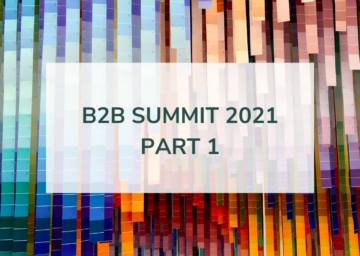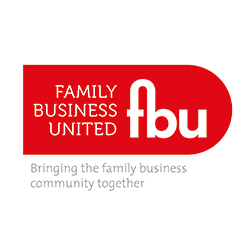B2B Summit 2021: The Changing World of B2B Communications (part 1)
29th November 2021 / All, Blog

At this year’s PR Week B2B Summit, comms and marketing practitioners came together to discuss the changes in the B2B communications and marketing landscape. With topics such as curating creativity, business agility, and humanising campaigns, the summit offered a deep dive into the areas which matter most to developing brand visibility, demographic reach, and fruitful business partnerships.
In this two-part blog series, we’ll be giving our concise summary of each talk, and there is still time to watch the event on-demand. Buy your ticket here.
In this first post, we’ll look at the following talks:
- Pivoting PR: transforming your strategy to stay human in an age of digitisation
- Do B2B comms professionals and clients actually care about brand purpose?
- Snackable content: making comms easily digestible
- Diversity and inclusion in b2b comms: where are we going wrong?
- Cultivating creativity: why B2B is boring no more
Without further ado, here’s our roundup and key takeaways:
- Pivoting PR: transforming your strategy to stay human in an age of digitisation
Speaker: Claire Gosnell – Global Head of Brand, Communications and Marketing at Clifford Chance
With businesses no longer able to meet in person, strategies have had to evolve digitally to ensure long-term relationships are still fostered and maintained. But how do we become more human in our B2B communications – or better yet – how do we turn ‘business-to-business’ into ‘human-to-human’?
As ever, good communications start with people. While B2B communications are largely based on facts and rational criteria, since Covid, the demand is for personal, candid, and authentic communications. People are looking for those kinds of messages now, and B2B companies are no exception. The fundamentals of effective campaigns have changed, and they aren’t changing back.
A good example of this is the notable rise of digital messaging. For B2B companies, this may seem threatening, but it is actually a huge enabler. It gives them opportunities to engage with audiences in a more meaningful way, by putting the audience’s interests first and delivering content that’s engaging and personal. Basically, the same thing we’ve always done. These actions bring our messages to life. Digital is a huge opportunity, but only if we can grasp the personal element of it.
Lastly, we looked at the trend of ‘changing expectations’. In a survey taken this year, 86% of respondents said that they expect CEOs to take a public stance on societal issues. People want to know what organisations believe in and whether they’re prepared to stand behind those beliefs. Audiences want to feel understood, but they also want to feel like they can understand and support the companies they interact with.
Key takeaways:
- See audiences as people – not as customers or product users, but as complex people.
- Understand what your business stands for and help deliver that every day
- Embrace diversity. Let’s understand how people see the world in a multitude of ways
“These changes are an exciting opportunity to do what we do best, more of the time” – Claire Gosnell.
2. Do B2B communications professionals and clients actually care about brand purpose?
Speakers: Eden Black – Head of Media relations at Nationwide. Melanie Derome – Global Social Impact Public Relations at Dell Technologies. Charlotte West – Executive Director, Global Corporate Communications at Lenovo. Lucy Linthwaite – External Communications Leader at IBM.
Do current trends suggest B2B clients and businesses actually care about purpose?
In the last 18 months, companies have moved away from talking about their ‘goals’ and are now talking about what they’re doing right now. But ‘purpose’ isn’t new, even if companies might not always have called it by that name.
Covid magnified issues across the UK, and so it’s been a great opportunity for businesses to play out their purpose and values, and to help their customers and clients internally as well as externally. People want to be shown action, and evidence of purpose, but while companies are quickly jumping on the bandwagon, it’s not always in the correct ways.
Companies need to stop and ask themselves: ‘how would the world be different if we didn’t exist?’ and if there’s no clear answer: their purpose is not as defined as it needs to be.
Look no further than the company itself. Your team members are either your most powerful advocates or your loudest critics, and so if they don’t buy into your purpose, then you need to rethink your strategy. It’s important that we engage team members, invite them into discussions on these topics, and allow them to be our brand ambassadors. Most importantly, you need to treat your people right, and it needs to be seen by the wider world.
Three important things companies need to do to consolidate their brand purpose:
- Align who they are as a company with what their core purpose is
- Embed this across their entire organisation
- Ensure that stakeholders and consumers feel and believe this purpose with every engagement they have.
3. Snackable content: making B2B communications easily digestible
Speaker: Amy Lawson – Executive Vice President, Global Head of Communications at Sage
With people being constantly exposed to content, attention spans are decreasing. How do comms professionals break through the noise?
Whether it’s at work, at home, B2B, or B2C, our brains are wired to do certain things when we receive certain stimuli. So, if we start with that premise, let’s look at how attention spans function in B2B contexts.
With an overwhelming amount of content to digest, ‘trends’ are getting shorter lifespans. Understanding your audiences means learning where they receive their information. Short-form content – like YouTube – is the most popular way of businesses learning information, even more so than from an official source – like gov.uk. Think about how you can go to the places that people are receiving their content from already, and then tailor your content into digestible pieces to fit the needs of those sites. Learn how to interact with new channels and platforms that are emerging, and furthermore, look at the emotions your audience are feeling and tailor your content to that feeling.
Failing to cultivate channel-appropriate content leads to reduced customer engagement, and so don’t try to force your voice into your content. Essentially, give the audience the mic.
Key points to remember:
- Humans will be humans, and more demanding attentions spans are a fact of life
- Listen to your audience and meet them where they are with content in a format that they already like
- With snackable content, personality wins over polish.
4. Diversity and inclusion in b2b comms: where are we going wrong?
Speaker: Raj Pattni – Media Relations Manager at Allen and Overy
Diversity and inclusion are just like any other communication challenges. To overcome it, you simply need to connect with your audience. It’s not just about getting the messaging right but it’s about bringing the story of your organisation to life. B2B communications are important, but translating your words into actions is vital.
Where can we improve?
This is something that organisations should be doing because it’s the right thing to do, not because they’ve heard that clients respond well to it. When we talk about getting diversity and inclusion wrong, it’s usually a case of organisations saying things that don’t connect with the people working at that organisation. If your messaging doesn’t resonate with your colleagues and clients, then there’s a disconnect.
One of the things you can do is involve people who are at the heart of the issue. Discussing these issues and encouraging conversations allows staff members to feel as if they can voice their concerns. Doing good internal communications then allows you to make those external comms more authentic. If you do one without the other, you risk a potential backlash.
There’s nothing wrong with saying ‘we’re not quite there yet’ but present a direction in which you would like to company to head.
Key tips and takeaways:
- Engage internal staff to ensure diversity and inclusion messages are consistent, authentic and internalised
- If you’re not authentic in your messaging, as well as your actions, then while you might be saying and doing the right things, your reputation may come to harm
- Offering alternative hiring routes broadens the scope of the applicants you’ll be getting, e.g., apprenticeships. Look beyond the Russell group to find new talent.
- Improving diversity on your comms teams will improve demographic reach.
5. Cultivating creativity: why B2B is boring no more
Speakers: Alexandra Frean – Head of Corporate Affairs at Starling Bank. David Arguello – Head of Marketing at Flor De Cana. Tessa Chen – Marketing and Communications at Vertex Ventures. Mark Choueke – Marketing Director at Mention Me. Isobel Sita-Lumsden – Head of B2B Marketing Europe at TikTok.
How do marketing and comms professionals define creativity within the B2B space?
While the traditional perception of creativity involves beautiful graphics and artwork, some companies, like Starling Bank, are redefining creativity. For them, creativity encompasses the telling of brilliant stories and the creation of a new business entity.
The difference between B2C and B2B communications may seem vast on the surface, but it’s all about forming connections, and by extension, storytelling. Whether you’re telling your story to a consumer, or to another business, the more unique your story and the values behind the brand, the more engaging it’s going to be.
The key to telling a memorable story often lies in your purpose: what’s behind the product? Why has it been made? Purpose-driven brands are undoubtedly the most successful, and it’s the job of B2B professionals to elevate those stories and make them stand out.
Key messages:
- B2B creativity mostly comes down to storytelling, and the ability to uncover and express the values of a brand
- You can’t have creativity without diversity
- The creativity of a simple idea should not be underrated
For more content from the B2B summit, head over to part 2 where we’ll be giving an overview of the following talks:
- Getting to grips with the new generation of B2B marketing: from the robot revolt to revolutionising ABM
- Title: RO-Why? Looking beyond measurement and ROI
- Talent Tinder: Do you need to break-up with your tech?
- Booming BETAs and the rise of tech-native buyers
(Access to each talk is available on-demand until December 23rd from PR Week)













